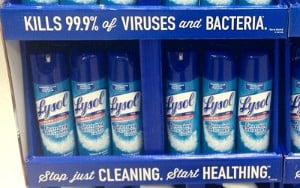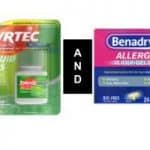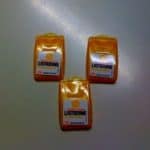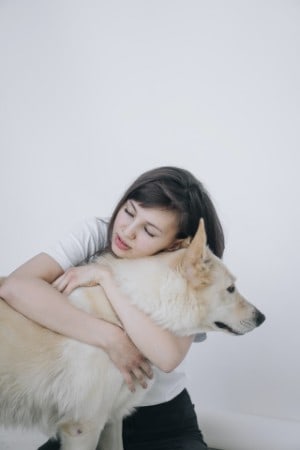
You’ve got a bit of a problem. You love your dog and there is nothing better than getting in close and giving them a real big squeeze. Or it is your dog that likes to climb up on the sofa in the evening and sit right next to you.
And both of those things are fine or they would be if it wasn’t for your dog’s bad breath.
Are dog’s condemned to always have bad breath? Let’s face it. Their food tends to be pretty disgusting and there is nothing they like better than a good old scavenge whilst out on a walk. Or can their breath be improved?
And so in this post, I want to look at adding baking soda into their drinking water as a possible cure.
Let’s cut to the chase and answer your main question first..
Baking soda in dogs water for bad breath
This is actually quite a controversial issue.
Some people recommend adding baking soda to your dog’s water bowl but many other people don’t.
And here’s why…
The origins of this idea probably comes from the fact that baking soda is used in human toothpaste.
Its abrasive nature helps to remove plaque from teeth and it will also act as a deodoriser by neutralising the bad smells from the bacteria in your mouth.
So why shouldn’t we use it in our dog’s drinking water?
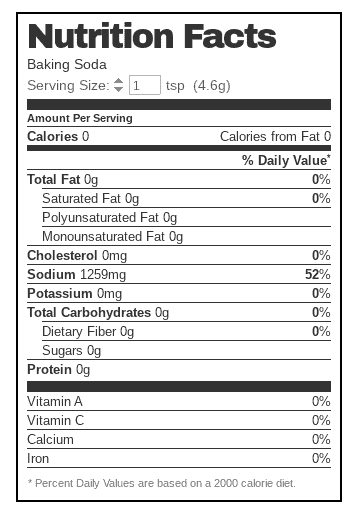
Although baking soda has some superpowers, it has very high levels of sodium which make it unsuitable to swallow or ingest.
Just one teaspoon of baking soda contains over 50% of our recommended daily allowance of sodium.
And if dogs ingest too much sodium it can cause sodium toxicosis, which can result in brain swelling and seizures.
Then how come it is used in toothpaste I hear you ask? Well the thing about toothpaste is that we only swallow tiny amounts of it.
Most of it we spit back out into the sink.
If we dissolve it into our dog’s drinking water they are swallowing all of it.
And there is another very good argument for not dissolving baking soda in a dog’s drinking water as a way to cure bad breath: and that is that there are so many good alternatives.
In a bit, I will look at all of those alternative home remedies for your dog’s bad breath but before do that, I want to take a step back.
It is all well and good explaining all of the great bad breath solutions that there are out there but before we do that I quickly want to go through all the possible symptoms of bad breath.
The symptoms of bad breath
Bad breath may not just be disgusting, it might be an indication that something is seriously wrong with your dog.
Gum disease in dogs affects over 87% of dogs that are aged three and over. This seems to be because dogs don’t have their teeth brushed and their mouths are more alkaline (than humans) which encourages more plaque.
One of several symptoms of this disease is bad breath.
And so, if your dog has persistent bad breath your first step should be to arrange a visit to see your vet because they can rule out any serious underlying causes.
In all likelihood, your dog’s bad breath is just related to a buildup of plaque in their mouth but bad breath can also be an indication of other worrying diseases such as liver disease, diabetes or kidney disease.
Once you have the all clear from your vet, it is time to look at other home remedies for your dog’s bad breath
Home remedies for dog’s bad breath
As I said, don’t be too disappointed about not being able to use baking soda to cure your dog’s stinky breath because there are loads of other easy to get hold of and cheap ingredients to help you with a home remedy.
Below I focus on just four possible home remedies for solving a dog’s bad breath but for a fuller list of nine solutions, you can read this page.
Access to clean fresh water
I am going to start with a simple one, that might seem a little odd to some of you but it is a basic “building block” of fighting your dog’s bad breath.
It is the cheapest solution in this list and the quickest to implement.
And it is this..
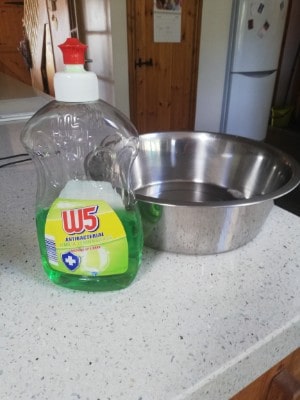
quickly…
Wash your dog bowl out regularly (I do it twice a day) with antibacterial dish soap and refill it with fresh water.
Dog water bowls contain a heady mix of dangerous germs.
These include E.coli, salmonella and MRSA.
These germs, if left unchecked, will not only make your dog’s breath worse, they could threaten the health of your dog and your family.
The more I think about it the more sense it makes that there is a clear relationship between better dog breath and clean water.
If a dog consumes clean water as it passes through the mouth and down the throat it washes many food particles away with it.
If a dog is drinking contaminated water, then this will also wash some food particles away with it but it will also leave lots of bits of old food in their mouth as well.
Celery
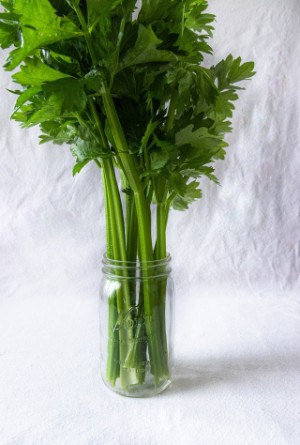
than an apple or carrot ²
Whilst many people know about the fresh breath powers of apples and carrots, fewer people are aware of celery’s potential to improve your dog’s breath.
Like apples and carrots, celery has that natural crunch to it which helps with pongy breath but unlike apples and carrots it has a much lower sugar content.
But don’t overdo the celery and be careful as it could be a choking hazard to smaller dogs. Use it as a treat and remember that your dog’s treat allowance should never exceed 10% of their daily diet.
Parsley
Used for centuries as a breath freshener for humans, parsley is safe for your dog to eat. It has a naturally minty flavor and its high levels of chlorophyll are said to help as a deodoriser.
Use about 1 teaspoon per 20 pounds of bodyweight.
Just be sure that you are using curly parsley and not spring parsley because the spring variety is toxic to dogs.
Apple Cider Vinegar
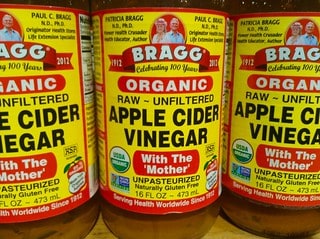
ACV is another staple of many households and it is another non toxic substance that is incredibly versatile.
But what is it? ACV is made by fermenting crushed apples with yeast to produce alcohol. When bacteria are added to the alcohol it transforms into acetic acid- which is the main compound in any vinegar
But how does it help bad breath? Apple cider vinegar is very acidic which can help bad breath by killing off any bacteria in the mouth.
It is also thought to support the digestive system which is a bonus because sometimes a digestive system that is struggling can contribute to bad breath.
Now that we have tackled bad breath, I want to look again at baking soda: give it a second chance if you will.
If we shouldn’t really use it to freshen our dog’s breath, how else can we use it to help our dogs?
That is what the next section is all about.
Common Uses Baking Soda Dogs
In my research, I have discovered 9 safe ways in which you can use baking soda with your dog.
Importantly, they are all for external use- none of these require your dog to ingest or eat baking soda.
One of the downsides of dog ownership for most of us is that dog smell that permeates most of our homes.
No matter how much we vacuum the house or clean and dry our dogs after the wettest of walks, our house will still smell of dogs.
Baking soda’s natural ability to neutralise many bad odours can help in various ways around the home.
Below I will just mention some of my favourite methods, but if you want to look at a fuller list, go here.
Deodorising carpets
If you have a particularly smelly rug or carpet that could do with a freshen up, sprinkle some dry baking soda on it and leave for about 15 minutes.
Then just vacuum it all up and hopefully the bad odour will disappear together with the baking soda.
You can do the same thing before you vacuum your car.
And I don’t know about you, but our car reeks of dogs.
In fact because cars are so fiddly to vacuum, I would vacuum your car out first. Then sprinkle some dry baking soda down, wait a bit and vacuum it all up.
See if that doesn’t help with that nasty smell.
You can also try to neutralise that odour on your dog’s bedding.
When it is time to wash their bed, throw some baking soda in along with your washing powder
Dry and wet shampoo
Baking soda can also be used as a dry shampoo or wet shampoo on your dog.
After all, a dog’s coat is very similar to a carpet isn’t it?!
Just be very careful to avoid sprinkling it anywhere near their face.
To use it as a dry shampoo, start by brushing your dog to remove any loose hairs. Then rub some dry baking soda into their coat, wait for a few minutes and then brush the powder out.
You must get rid of all the baking soda so that you dog won’t ingest any as they clean themselves.
So maybe after brushing, rub them down with a dry towel-or find them some long grass or hay to roll in!
Skunk/ fox smell
If you live in the U.S then one of the hazards of owning a dog is when they get sprayed by a skunk.
For dog owners in the U.K, a similar hazard is when a dog rolls in fox poop.
The result is the same- your dog stinks in the most obnoxious way.
Ordinary shampoos can clean the dog but not get rid of the smell.
Step forward baking soda, which will work miracles in reducing the awful smell.
Tomato Ketchup is also very good at neutralising the smell.
Closing Thoughts
To sum up- adding baking soda to your dog’s water as a way to freshen bad breath is probably best avoided.
Persistent bad breath does need to be checked out by your vet, just in case it is the symptom of a more serious medical condition.
But once you get the all clear from your vet, there are plenty of other home remedies that can help you in your fight against canine halitosis! One of these is apple cider vinegar.
And don’t give up on using baking soda with your dog. There are plenty of ways that it can be used safely with your dog- just make sure that your dog doesn’t ingest it.
Photo Credits
¹ Photo by Sasha Sashina on Unsplash
² Photo by Sophie Mikat on Unsplash
³ Photo by Mike Mozart on Flickr
⁴
⁵
⁶
⁷
⁸
⁹



